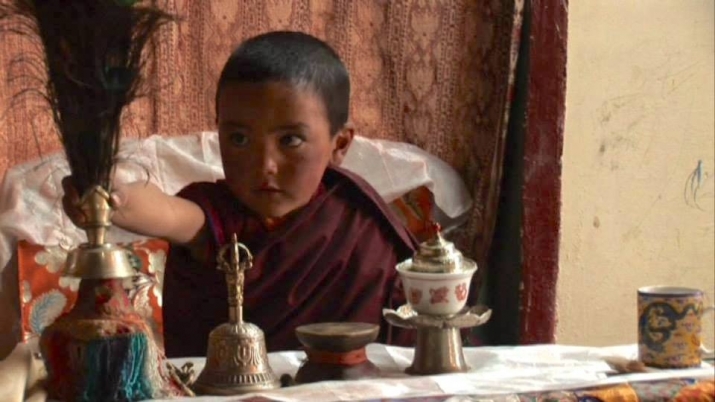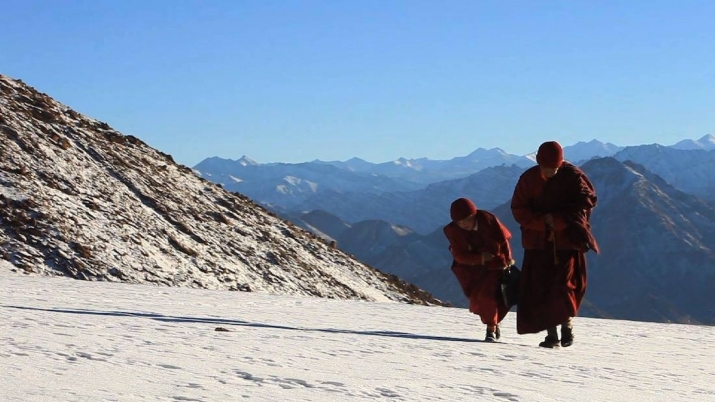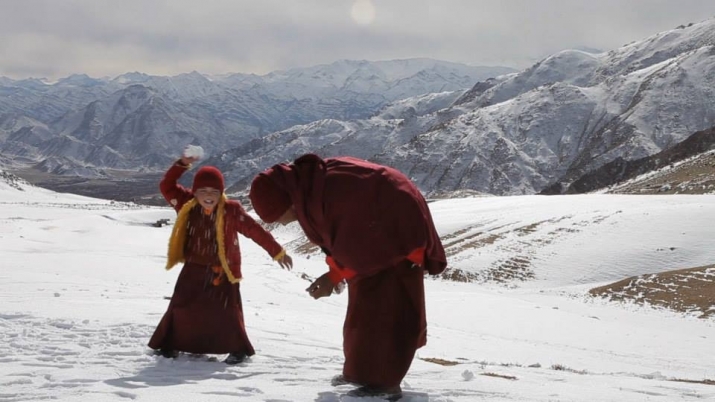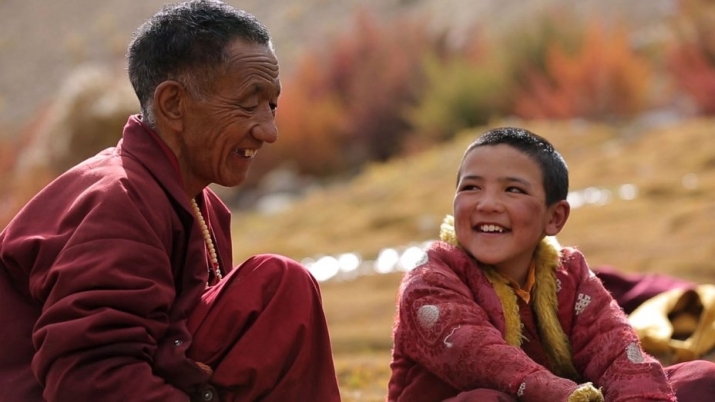By Craig Lewis Buddhistdoor Global 2017-02-21
 Filmed over an eight-year period, the documentary follows the life of Padma Angdu, who is recognized as the incarnation of a high-ranking Tibetan lama. From facebook.com
Filmed over an eight-year period, the documentary follows the life of Padma Angdu, who is recognized as the incarnation of a high-ranking Tibetan lama. From facebook.com
Following its worldwide premier at the Berlin International Film festival
last week, a new documentary on Tibetan Buddhism, Becoming Who I
was, by South Korean directors Chang-Yong Moon and Jin Jeon has been
picked up for distribution in the US and Canada, under a deal that includes
a premier in New York City later this year, to be followed by nationwide
cinema, DVD, and digital releases.
Filmed over an eight-year period, the documentary follows the life of an ordinary boy, Padma Angdu, born to the Tibetan diaspora in the Himalayan last week, a new documentary on Tibetan Buddhism, Becoming Who I
was, by South Korean directors Chang-Yong Moon and Jin Jeon has been
picked up for distribution in the US and Canada, under a deal that includes
a premier in New York City later this year, to be followed by nationwide
cinema, DVD, and digital releases.
state of Jammu and Kashmir, in India’s far north. Padma’s difficulties begin
when he is recognized as the incarnation of a high-ranking Tibetan lama
and enthroned as a rinpoche at the tender age of six. Four years pass as
Padma waits for his disciples from Tibet to come and find him, yet no one arrives, and the boy is eventually cast out of the local monastery in Ladakh.
The village doctor, Urgyan, takes the boy under his wing and the pair resolve
to undertake the arduous journey to Padma’s cultural and spiritual homeland
in Tibet, far from his home in the highlands of northern India. However,
political instability in Tibet makes the prospect of traveling to his monastery there even more daunting. Undeterred, the pair set off for their destination
on foot, accompanied by questions of love, friendship, and the nature of life
and destiny.
to undertake the arduous journey to Padma’s cultural and spiritual homeland
in Tibet, far from his home in the highlands of northern India. However,
political instability in Tibet makes the prospect of traveling to his monastery there even more daunting. Undeterred, the pair set off for their destination
on foot, accompanied by questions of love, friendship, and the nature of life
and destiny.
 Padma and his guardian Urgyan set off on foot on the arduous journey to his cultural and spiritual homeland in Tibet. From facebook.com
Padma and his guardian Urgyan set off on foot on the arduous journey to his cultural and spiritual homeland in Tibet. From facebook.com
“Set in nature’s astounding beauty in the barren land of Ladakh, we follow
two characters caught between a rock and a hard place,” the films producers said in a public statement. “Humor is threaded throughout the film to allow
us to connect to the characters, who are as human and as flawed as we are.
As circumstances change over the years, we witness a boy growing up and entering into adolescence, filled with questions around his identity. In order
to compensate for four years of waiting with no results—and no option of
going to Tibet themselves—Urgyan compromises his own beliefs and even
gives up his job as the only doctor in the region. We witness the unfaltering
love that Urgyan reveals amid the growing insecurities and fears that
resurface with his old age. The universal truths of unconditional love,
sacrifice, aging, adolescence, and identity crisis are ‘re-lived’ through this intimate and emotion-filled film.” (Facebook)
two characters caught between a rock and a hard place,” the films producers said in a public statement. “Humor is threaded throughout the film to allow
us to connect to the characters, who are as human and as flawed as we are.
As circumstances change over the years, we witness a boy growing up and entering into adolescence, filled with questions around his identity. In order
to compensate for four years of waiting with no results—and no option of
going to Tibet themselves—Urgyan compromises his own beliefs and even
gives up his job as the only doctor in the region. We witness the unfaltering
love that Urgyan reveals amid the growing insecurities and fears that
resurface with his old age. The universal truths of unconditional love,
sacrifice, aging, adolescence, and identity crisis are ‘re-lived’ through this intimate and emotion-filled film.” (Facebook)
Co-director Chang-Yong Moon was in the region in 2009 to film a
documentary about traditional Asian medicine when he first encountered Padma’s guardian, Urgyan. “When I met him, I also saw a
boy, Padma Angdu, who was always with him, at that time the boy was
not yet known as Rinpoche,” Moon recalled. (Deutschlandradio Kultur)
documentary about traditional Asian medicine when he first encountered Padma’s guardian, Urgyan. “When I met him, I also saw a
boy, Padma Angdu, who was always with him, at that time the boy was
not yet known as Rinpoche,” Moon recalled. (Deutschlandradio Kultur)
 The pair set off on their long journey, accompanied by questions of love, friendship, and the nature of life and destiny. From facebook.com
The pair set off on their long journey, accompanied by questions of love, friendship, and the nature of life and destiny. From facebook.com
But five-year-old Padma was no ordinary child: “In my last life, I lived in
Kham, in Tibet. I still remember the place, and I was born in Sakti in the present day, and people call me Padma Angdu,” Padma said.
(Deutschlandradio Kultur)
Kham, in Tibet. I still remember the place, and I was born in Sakti in the present day, and people call me Padma Angdu,” Padma said.
(Deutschlandradio Kultur)
Over the course of the documentary, the young reincarnate is forced to
confront the difficult realities of survival, coming-of-age, and serving a
sacred tradition amid the harsh backdrop of the Himalayas. Accompanied
by his aging guardian, Padma embarks on a journey to find his place in
the world.
confront the difficult realities of survival, coming-of-age, and serving a
sacred tradition amid the harsh backdrop of the Himalayas. Accompanied
by his aging guardian, Padma embarks on a journey to find his place in
the world.
“Becoming Who I Was is a charming film that synthesizes both a coming-
of-age story, a road trip, and a love story between a young master and
his guardian,” said Elizabeth Sheldon, chief operating officer of distribution company Bond/360. “The film will captivate audiences both young and old around the world.” (Variety)
of-age story, a road trip, and a love story between a young master and
his guardian,” said Elizabeth Sheldon, chief operating officer of distribution company Bond/360. “The film will captivate audiences both young and old around the world.” (Variety)
 From hollywoodreporter.com
From hollywoodreporter.com
Becoming Who I Was (trailer) (Vimeo)
No comments:
Post a Comment